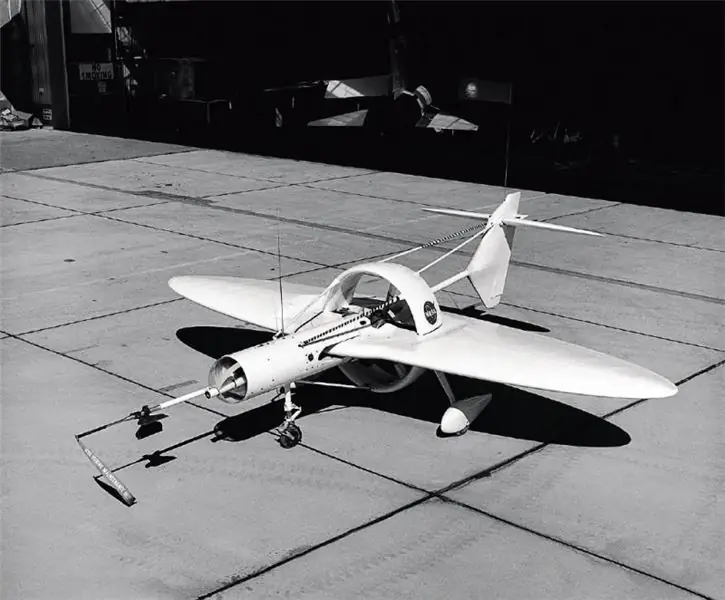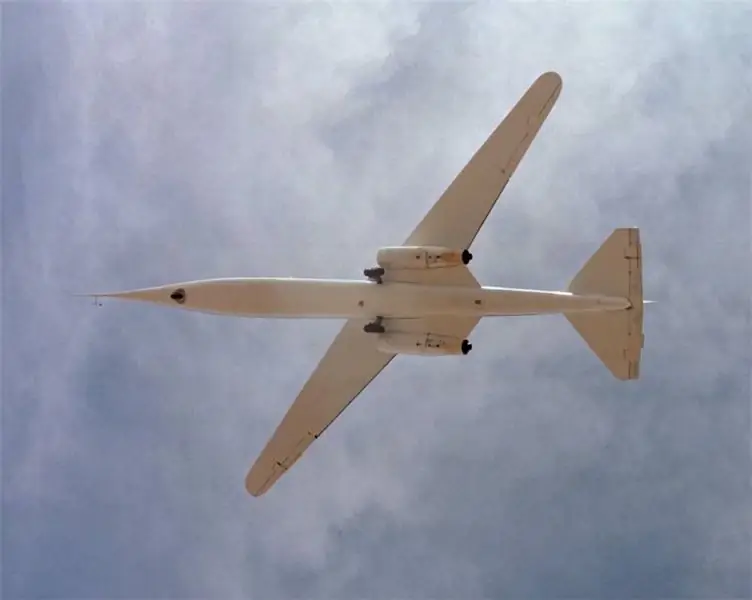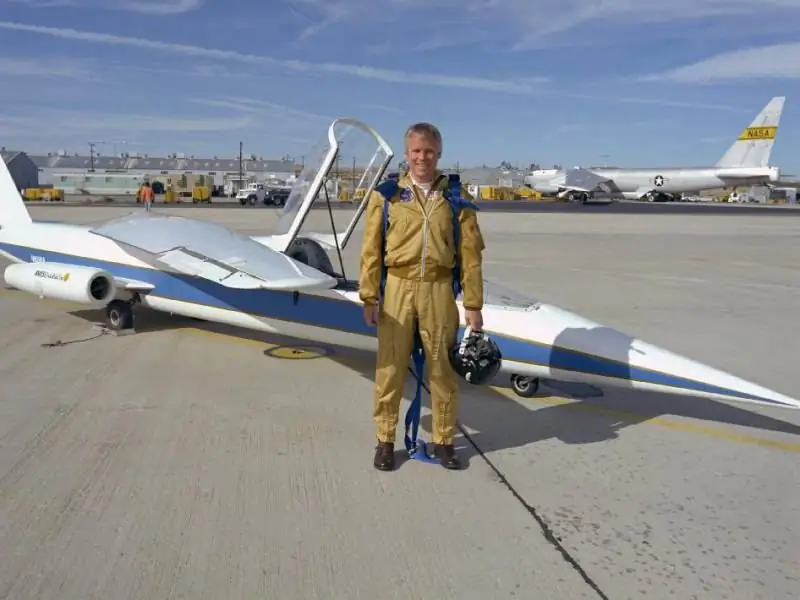- Author Matthew Elmers [email protected].
- Public 2023-12-16 21:49.
- Last modified 2025-01-24 09:17.

As you know, the center section is the very part of the aircraft wing that connects the left and right planes and serves, in fact, to attach the wing to the fuselage. In accordance with the logic, the center section should be a rigid structure. But on December 21, 1979, a NASA AD-1 aircraft took off, whose wing was attached to the fuselage … on a hinge and could rotate, giving the aircraft an asymmetric shape.
However, it all started much earlier - with the gloomy Teutonic genius Richard Vogt, chief designer of the legendary company Blohm & Voss. Vogt, known for his atypical approach to the design of aircraft, had already built asymmetric aircraft and knew that such a scheme did not prevent the aircraft from being stable in the air. And in 1944, the Blohm & Voss and P.202 project was born.
Vogt's main idea was the ability to significantly reduce drag when flying at high speeds. The aircraft took off with a conventional symmetrical wing (since a low sweep wing has a high lift coefficient), and in flight it turned in a plane parallel to the fuselage axis, thereby reducing drag. Actually, this was one of the solutions for the implementation of a variable sweep of the wing - at the same time the Germans worked out the classic symmetrical sweep on the Messerschmitt P.1101 aircraft.
Blohm & Voss and P.202 seemed too crazy to go into the series. Its wing with a span of 11, 98 m could turn on the central hinge at an angle of up to 35 ° - at the maximum angle, the span changed to 10, 06 m. inability to use the wing for mounting additional equipment. The project remained only on paper.
At the same time, specialists from Messerschmitt were working on a similar project. Their vehicle, the Me P.1109, received the nickname "scissor wing". The car had two wings, and externally independent: one was located above the fuselage, the second - under it. When the upper wing was turned clockwise, the lower wing was similarly turned counter-clockwise - this design made it possible to qualitatively compensate for the skew of the aircraft with an asymmetric change in sweep.
The wings could rotate up to 60 °, and when they were perpendicular to the fuselage axis, the aircraft looked like a regular biplane.
The Messerschmitt's difficulties were the same as those of Blohm & Voss: a complex mechanism and, in addition, problems with the chassis design. As a result, even an aircraft built in iron with a symmetrically variable sweep - Messerschmitt Р.1101, did not go into production, let alone asymmetric structures that remained only projects. The Germans were too far ahead of their time.
Benefits and losses
The advantages of an asymmetrically variable sweep are the same as those of a symmetrical sweep. When the plane takes off, a high lift is required, but when it flies at a high speed (especially above the speed of sound), the lift is no longer so relevant, but the high drag begins to interfere. Aviation engineers have to find a compromise. By changing the sweep, the aircraft adapts to the flight mode. Calculations show that positioning the wing at an angle of 60 ° to the fuselage will significantly reduce aerodynamic drag, increasing the maximum cruising speed and reducing fuel consumption.
But in this case, a second question arises: why do we need an asymmetric sweep change, if a symmetrical one is much more convenient for the pilot and does not require compensation? The fact is that the main drawback of symmetrical sweep is the technical complexity of the change mechanism, its solid mass and cost. With an asymmetric change, the device is much simpler - in fact, an axle with a rigid attachment of the wing and its turning mechanism.
Such a scheme is on average 14% lighter and minimizes the characteristic impedance when flying at speeds exceeding the speed of sound (that is, the advantages are also manifested in flight performance). The latter is caused by a shock wave that occurs when part of the air flow around the aircraft acquires supersonic speed. Finally, this is the most "budgetary" variant of the variable sweep.

OWRA RPW
An unmanned aerial vehicle by NASA, built in the early 1970s for the experimental study of the flight properties of asymmetric sweep. The device was able to rotate the wing 45 ° clockwise and existed in two configurations - short-tailed and long-tailed.
Therefore, with the development of technology, humanity could not help but return to an interesting concept. In the early 1970s, an unmanned aerial vehicle OWRA RPW (Oblique Wing Research Aircraft) was manufactured by order of NASA to study the flight properties of such a scheme. The development consultant was Vogt himself, who emigrated to the United States after the war, at that time already a very elderly man, and the chief designer and ideologist of the revival of the idea was NASA engineer Richard Thomas Jones. Jones had been rooting for this idea since 1945, when he was an employee of NACA (the predecessor of NASA, the National Advisory Committee for Aeronautics), and by the time the prototype was built, absolutely all theoretical calculations had been worked out and thoroughly tested.
The OWRA RPW wing could rotate up to 45 °, the drone had a rudimentary fuselage and tail - in fact, it was a flying layout, the central and only interesting element of which was the wing. Most of the research was carried out in an aerodynamic tunnel, some in real flight. The wing performed well, and NASA decided to build a full-fledged aircraft.
And now - fly
Of course, the asymmetric sweep change also has disadvantages - in particular, the asymmetry of the frontal resistance, parasitic turning moments leading to excessive roll and yaw. But all this already in the 1970s could be defeated by partial automation of controls.

Airplane NASA AD-1
He flew 79 times. In each flight, the testers put the wing in a new position, and the data obtained were analyzed and compared with each other.
The AD-1 (Ames Dryden-1) aircraft has become the joint brainchild of a number of organizations. It was built in iron by Ames Industrial Co., the overall design was done on Boeing, technology research was conducted by Bertha Rutana's Scaled Composites, and flight tests were conducted at the Dryden Research Center in Lancaster, California. The AD-1 wing could rotate on the central axis by 60 °, and only counterclockwise (this greatly simplified the design without losing advantages).
The wing was driven by a compact electric motor located inside the fuselage directly in front of the engines (the latter used the classic French turbojet engines Microturbo TRS18). The span of the trapezoidal wing in the perpendicular position was 9, 85 m, and in the rotated position - only 4, 93, which made it possible to reach a maximum speed of 322 km / h.
On December 21, AD-1 took off for the first time, and over the next 18 months, with each new flight, the wing was rotated 1 degree, recording all the aircraft's indicators. In mid-1981, the aircraft reached its maximum angle of 60 degrees. Flights continued until August 1982, in total, the AD-1 took off 79 times.

NASA AD-1 (1979)
The only aircraft with an asymmetric sweep wing that took off into the air. The wing rotated up to 60 degrees counterclockwise.
Jones' main idea was to use asymmetric sweep changes in aircraft for intercontinental flights - speed and fuel economy paid for themselves best at ultra-long distances. The AD-1 aircraft really received positive reviews from both experts and pilots, but, oddly enough, the story did not receive any continuation. The problem was that the entire program was primarily research. Having received all the necessary data, NASA sent the plane to the hangar; 15 years ago, he moved to eternal storage at the Hillier Aviation Museum in San Carlos.
NASA, as a research organization, was not engaged in aircraft construction, and none of the major aircraft manufacturers were interested in Jones' concept. Intercontinental liners by default are much larger and more complex than the "toy" AD-1, and the companies did not dare to invest huge sums of money in research and development of a promising, but very suspicious design. Classic won out over innovation.

Richard Gray, NASA AD-1 Test Pilot
Having successfully flown off his program on an asymmetric wing, he died in 1982 in the crash of a private trainer aircraft Cessna T-37 Tweet.
Subsequently, NASA returned to the "oblique wing" theme, having built in 1994 a small drone with a wingspan of 6, 1 m and the ability to change the sweep angle from 35 to 50 degrees. It was built as part of the creation of a 500-seat transcontinental airliner. But in the end, work on the project was canceled for the same financial reasons.
It's not over yet
Nevertheless, the oblique wing received a third life, this time thanks to the intervention of the well-known agency DARPA, which in 2006 offered Northrop Grumman a 10 million contract for the development of an unmanned aerial vehicle with an asymmetric sweep change.
But the Northrop corporation went down in aviation history primarily due to its development of aircraft type "flying wing": the founder of the company, John Northrop was an enthusiast of such a scheme, from the very beginning he set the direction of research for many years to come (he founded the company in the late 1930s, and died in 1981).
As a result, Northrop specialists decided to cross the technology of the flying wing and asymmetric sweep in an unexpected way. The result was the Northrop Grumman Switchblade drone (not to be confused with their other conceptual development - the Northrop Switchblade fighter).
The drone design is quite simple. Attached to the 61-meter wing is a hinged module with two jet engines, cameras, control electronics and attachments necessary for the mission (for example, missiles or bombs). The module has nothing superfluous - the fuselage, plumage, tail, it resembles a balloon gondola, except perhaps with power units.
The angle of rotation of the wing relative to the module is still the same ideal 60 degrees, calculated back in the 1940s: at this angle, the shock waves arising when moving at supersonic speed are leveled. With its wing rotated, the drone is capable of flying 2,500 miles at a speed of 2.0 M.
The concept of the aircraft was ready by 2007, and by the 2010s, the company promised to conduct the first tests of a layout with a wingspan of 12.2 m - both in a wind tunnel and in real flight. Northrop Grumman planned that the first flight of the full-size drone would take place around 2020.
But already in 2008, the DARPA agency lost interest in the project. Preliminary calculations did not produce the planned results, and DARPA withdrew the contract, closing the program at the computer model stage. So the idea of asymmetric sweep was out of luck again.
Will it or won't it?
In fact, the only factor that killed an interesting concept was economics. Having working and proven circuits makes it unprofitable to develop a complex and untested system. It has two areas of application - transcontinental flights of heavy liners (the main idea of Jones) and military drones capable of moving at speeds exceeding the speed of sound (the primary task of Northrop Grumman).
In the first case, the advantages are fuel economy and an increase in speed, all other things being equal with conventional airliners. In the second, the minimization of the wave drag at the moment when the aircraft reaches the critical Mach number is of greatest importance.
Whether a serial aircraft with a similar configuration will appear depends solely on the will of aircraft manufacturers. If one of them decides to invest money in research and construction, and then prove in practice that the concept is not only functional (this has already been proven), but also self-sustaining, then the asymmetric change in sweep has a chance of success. If, within the framework of the global financial crisis, such daredevils are not found, the "oblique wing" will remain another part of the history of aviation rich in curiosities.
Characteristics of the NASA AD-1 aircraft
Crew: 1 person
Length: 11, 83 m
Wingspan: 9.85 m perpendicular, 4.93 m oblique
Wing angle: up to 60 °
Wing area: 8, 6 2
Height: 2, 06 m
Empty aircraft weight: 658 kg
Max. takeoff weight: 973 kg
Powertrain: 2 x Microturbo TRS-18 jet engines
Thrust: 100 kgf per engine
Fuel capacity: 300 liters Maximum speed: 322 km / h
Service ceiling: 3658 m
True pioneers
Few people know that the first aircraft with variable wing geometry was not built by the Germans during the Second World War (as most sources claim), but by the French aviation pioneers Baron Edmond de Marcai and Emile Monin back in 1911. The Markay-Monin monoplane was presented to the public in Paris on December 9, 1911, and six months later made its first successful flight.
Actually, de Marcay and Monin came up with the classic scheme of symmetrically variable geometry - two separate wing planes with a total maximum span of 13.7 m were attached to the hinges, and the pilot could change the angle of their location relative to the fuselage right in flight. On the ground, for transportation, the wings could be folded, like the wings of insects, "behind the back." The complexity of the design and the need to move to more functional aircraft (due to the outbreak of war) forced the designers to abandon further work on the project.






